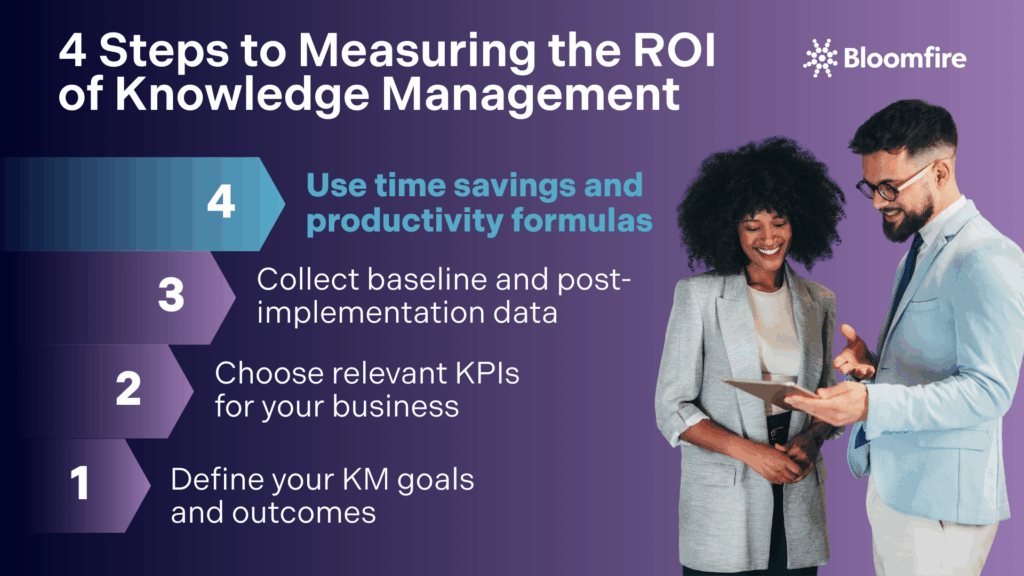How to Measure the ROI of Knowledge Management

Measuring knowledge management ROI remains one of the most challenging aspects of KM initiatives. While leaders intuitively understand the value of better knowledge sharing, translating this into concrete financial returns often feels like trying to measure the unmeasurable.
Fortunately, calculating the ROI of knowledge management doesn’t have to be a matter of guesswork. Start by aligning your expected outcome with your business goals, then focus on specific metrics such as time saved, employee retention, and improved decision-making speed. Ensure that you calculate a quantifiable ROI to demonstrate the tangible impact of your KM initiatives.
This step-by-step guide will show you exactly how to measure knowledge management performance, determine its impact, and calculate its ROI using proven methodologies that work for various organizations.
Expert tip:
Skip manually measuring knowledge management ROI. Use Bloomfire’s ROI calculator to determine your knowledge management returns.
Calculate KM ROI Now!Why Measuring Knowledge Management ROI Matters
Suppose your organization or department lacks a robust knowledge management framework. In that case, you can likely identify the challenges you need to address: information is scattered across various repositories, teams are out of sync, and the organization loses valuable knowledge when employees leave the company.
But what if you’re asked to quantify the benefits of knowledge management? That might feel more challenging. Leaders often look closely at the positive outcomes and return on investment (ROI) of knowledge management.
Measuring and communicating ROI is especially critical during times of change or uncertainty, when many businesses are adjusting their priorities and seeking to ensure the most cost-effective investments. It isn’t just about justifying expenses—it’s about maximizing the impact of your knowledge management initiatives.
The business case for KM investment
The financial case for knowledge management is compelling. Studies show that productivity improvements have a remarkable ripple effect—a modest 5% increase in productivity has been associated with a 50% increase in total shareholder return. Furthermore, companies waste approximately $2 million annually when 1,000 employees with average salaries of $60,000 spend 20% of their workday searching for information.
The stakes are even higher considering that Fortune 500 companies lose at least $31.5 billion yearly by failing to share knowledge effectively. Additionally, disengaged employees cost the US economy roughly $350 billion annually in lost productivity, accidents, theft, and turnover.
How to Measure Knowledge Management ROI Step-by-Step
Transforming knowledge management from a cost center to a value generator requires a systematic approach to ROI measurement. The process can be encapsulated in these four critical steps. Following these steps allows organizations to effectively quantify the impact of their knowledge management initiatives and demonstrate clear financial returns.

1. Define your KM goals and outcomes
Setting clear, measurable objectives is the foundation of effective ROI measurement. Rather than vague goals like “improve knowledge sharing”, create specific targets such as “reduce time spent searching for information by 30% within six months” or “increase employee problem-solving efficiency by improving access to critical knowledge resources”.
Well-defined KM goals and objectives serve two essential purposes. First, they establish realistic expectations about potential impacts from knowledge management. Second, they provide a foundation for defining and measuring KM’s expected contribution to the business. The more precisely you can articulate these objectives, the more likely you’ll secure appropriate support and funding.
2. Choose relevant KPIs for your business
Once you’ve established clear objectives, select metrics, down to specific KM key performance indicators (KPIs), that reflect your specific goals. Remember that what might be a critical indicator for one organization could be secondary for another, depending on business challenges, KM adoption goals, team size, and customer expectations.
A comprehensive measurement approach should include:
- Efficiency metrics: time saved, reduced training costs
- Effectiveness metrics: employee productivity, innovation rates
- Financial metrics: cost savings, revenue impact
- Engagement metrics: user participation, knowledge contributions
For optimal results, combine both quantitative KPIs (like average handle time or first contact resolution rate) and qualitative indicators (such as eliminating data silos or improving employee satisfaction). This balanced approach provides a holistic view of your KM system’s effectiveness.
3. Collect baseline and post-implementation data
Before launching your knowledge management system, establish benchmark measurements by tracking current inefficiencies, such as the frequency at which employees escalate issues or the number of hours lost searching for documentation. This baseline data is crucial—without it, it’s almost impossible to make robust claims about your intervention’s contribution to observed changes over time.
Although gathering baseline evidence could become an extensive exercise, focus on:
- Identifying and quantifying the people who will directly benefit
- Noting implementation locations and timeframes
- Describing the operating context
- Establishing relevant performance indicators
For baseline collection, consider developing standardized survey tools or conducting key informant interviews using semi-structured questions. Subsequently, schedule regular knowledge management audits every six months to assess whether your knowledge base delivers the intended results.
4. Use time savings and productivity formulas
To calculate concrete ROI, use this standard formula:
ROI (%) = [(Net Benefits – KM Investments) / KM Investments] × 100
(You can also use our automated knowledge management ROI calculator for a more tailored approach.)
For net benefits, quantify the dollar value of advantages like saved time, reduced errors, or enhanced team output. KM investments should include both upfront costs (software, setup fees, etc.) and ongoing expenses (maintenance, training, etc.).
Regular analysis of collected data allows you to identify patterns, trends, and improvement areas based on user behavior, content relevance, and overall knowledge management effectiveness. This ongoing measurement cycle ensures your KM system continues delivering optimal value.
Key Metrics to Track for KM ROI
Tracking specific metrics provides concrete evidence of how different knowledge management systems deliver measurable returns on investment. Research shows that properly implemented KM systems can reduce operational costs through more efficient information management. But where to start?
The specific outcomes and key performance indicators (KPIs) will depend on your business and the objectives you’re focused on achieving, but knowledge management system ROI can be measured across three fundamental areas: retention, innovation, and revenue.
a. Retention
Knowledge management enables entire organizations to gain a holistic view of the customer, resulting in increased customer satisfaction and loyalty. However, knowledge management doesn’t just enhance customer retention; it can also improve employee retention.
Outcomes:
- Increased customer satisfaction and loyalty through better customer experiences
- Higher employee satisfaction and engagement with decreased information frustration
- Reduced duplication of work or loss of information and intelligence
KPIs:
- Customer Satisfaction (CSAT) and Net Promoter Scores (NPS)
- Time saved per employee (productivity gain)
- Average decrease in redundant work
- Contribution views in the knowledge engagement platform
- Decrease in average employee onboarding time
- Training materials delivered
A culture of knowledge engagement demonstrates to employees that their knowledge is valued. It provides them with opportunities to collaborate with their peers and offers them visibility into how their work supports larger organizational goals, all of which contribute to greater job satisfaction.
b. Innovation
Innovation requires businesses to apply, combine, and build upon existing ideas in a way that leads to something new and useful to the customer. A knowledge management system enables businesses to consolidate knowledge and insights from across the organization, fueling innovation.
Outcomes:
- Collaboration and cross-functional engagement on new ideas and information
- Delivery of insights to propel and inform business and go-to-market decisions
- Knowledge creation and augmentation to fuel competitive advantage
KPIs:
- Knowledge and insights contributed to the knowledge management platform
- Consumption and communication of insights by business decision-makers and stakeholders
- Search volume and keyword trends in the knowledge management platform
- Collaboration and engagement metrics in a knowledge management platform (e.g., comments, questions, shares)
Innovation demonstrates the effective application and creation of new knowledge within an organization. It directly links the successful sharing and leveraging of internal expertise to tangible outcomes, such as new products, services, or improved processes, which are direct measures of organizational growth and value.
c. Revenue
Knowledge management can increase revenue in two key ways. First, on-demand access to knowledge enables employees to be more productive, resulting in increased output and cost savings from operational improvements. Second, organizations can increase revenue through new products, services, and processes that arise from cross-functional innovation and knowledge sharing.
Outcomes:
- Reduced time spent searching for information and increased time spent on impactful activities
- Elimination of information silos between departments and teams
- Reduction of work errors and redundant activities
- A faster decision-making process and the ability to take action
KPIs:
- Productivity gains (measured in time saved)
- Average decrease in redundant work
- Average decrease in work errors
- Contribution views in the knowledge engagement platform
- Increase in contributions, comments, questions, and answers in the knowledge engagement platform
- Bottom line revenue increases
It is an established principle that knowledge management can increase revenue by improving employee productivity, accelerating time to market for new products and services, and enhancing customer satisfaction. In turn, these developments lead to greater sales and customer retention.
Measuring Knowledge Management ROI with Real Examples
Key performance indicators provide a framework for quantifying the impact of knowledge initiatives on business operations and financial results. This approach allows a company to clearly demonstrate how knowledge management contributes to efficiency, productivity, and innovation. Here are examples of how you can measure the ROI of knowledge management based on specific KPIs.
1. Estimating the ROI of knowledge management based on time savings
The sample outcomes and KPIs above should give you a good idea of what you can start measuring after implementing a knowledge management platform. But you may also need to estimate the ROI of knowledge management before purchasing new technology so that you can make a strong business case.
One way to come up with an estimate is to crunch the numbers on the time employees will save searching for information. According to McKinsey & Company, employees spend 20% of their day looking for information they need to do their jobs. That’s a day a week.
Time savings remain among the most straightforward ways to demonstrate knowledge management ROI. Initially, consider that employees spend approximately 1.8 hours daily searching for relevant information. For a company of just 150 employees with average salaries of USD 60,000, reducing search time by half yields annual savings of USD 750,000.
Based on redundant work reduction
Employees spend approximately 2 hours weekly recreating information that already exists elsewhere in their organization. Moreover, they waste another 1.7 hours providing duplicate information or repeating answers.
This redundancy represents significant productivity loss across organizations. Measuring reductions in duplicated work directly correlates to cost savings, as each reused document, solution, or template represents avoided effort. If a $5,000 research task is avoided 300 times yearly because the answer already exists in the KM system, that’s $1,500,000 saved without additional headcount.
2. Estimating knowledge management ROI based on employee engagement and retention
Knowledge workers with access to efficient KM systems report significantly less frustration, stress, and lowered job satisfaction. Indeed, they’re less likely to consider leaving their employer due to productivity issues.
This impact on retention delivers substantial value, considering the high costs associated with turnover. Organizations with robust KM practices experience approximately 25% improvement in productivity and 15% increase in employee satisfaction.
Companies that prioritize employee engagement, where knowledge sharing is foundational, experience a 21% increase in profitability and a 41% reduction in absenteeism. On the contrary, replacing a single employee can cost between 50% and 200% of their annual salary, depending on their seniority.
3. Estimating knowledge management ROI based on faster innovation
Fast and innovative companies outperform their industry averages by 9.8% and 11.6% points in net profit margin and revenue growth, respectively. Mercedes-Benz exemplifies this advantage, increasing earnings before interest and taxes by 28% year-over-year through strategic innovation initiatives.
Organizations with effective knowledge practices experience better cross-functional collaboration, enabling faster product development and market response. In essence, KM systems that facilitate knowledge sharing and discovery become catalysts for innovation-driven revenue growth.
Frequently Asked Questions
What is win-loss analysis in calculating KM ROI?
Win-loss analysis involves the systematic gathering and analysis of data on why a company wins and loses sales opportunities. This analysis helps to quantify the value of knowledge assets, revealing how access to timely and accurate information influenced the outcome of a sale, thereby providing a direct link between knowledge management initiatives and revenue.
How do you build a business case for knowledge management?
Building a business case for knowledge management requires a clear articulation of the problem it solves and a quantifiable projection of its financial and operational benefits. The business case must align knowledge management initiatives with organizational strategic goals and demonstrate a positive return on investment, which can be achieved through a cost-benefit analysis and the use of relevant KPIs.
What is the difference between measuring knowledge management performance and ROI?
KM performance measurement focuses on operational metrics that demonstrate the effectiveness of knowledge management activities (e.g., the number of articles viewed, user adoption rates, and search success rates). KM ROI specifically translates these performance metrics into a financial value to determine the ultimate return on the investment.
Knowledge Management ROI Calculation: Measure Early and Often
We’ve included many ways to measure the ROI of knowledge management–and not every metric or outcome will make sense for your business. But no matter what your specific use case, the key to assessing and communicating your company’s knowledge management ROI is to define the relevant metrics for your business objectives and then measure and report on them regularly. It can also be impactful to pair your data with success stories.
It’s clear that the knowledge existing across your business is valuable, and measuring the ROI of your knowledge management strategy’s best practices can help your organization understand just how significant an impact its collective intelligence has on revenue, retention, and innovation.
Note: This blog post was expanded and updated in September 2025. Some parts of this article were generated with the assistance of artificial intelligence, under the supervision and editing of our editorial team.
Maximize Your KM ROI With Bloomfire
Experience a KM solution that treats you as a lifelong partner!
Talk to Our Expert

Enterprise AI Search: Definition, Benefits, and Evolution

The Benefit of Company-Wide Knowledge Management in 2026

Are You Making These Common Knowledge Sharing Mistakes?

Estimate the Value of Your Knowledge Assets
Use this calculator to see how enterprise intelligence can impact your bottom line. Choose areas of focus, and see tailored calculations that will give you a tangible ROI.

Take a self guided Tour
See Bloomfire in action across several potential configurations. Imagine the potential of your team when they stop searching and start finding critical knowledge.